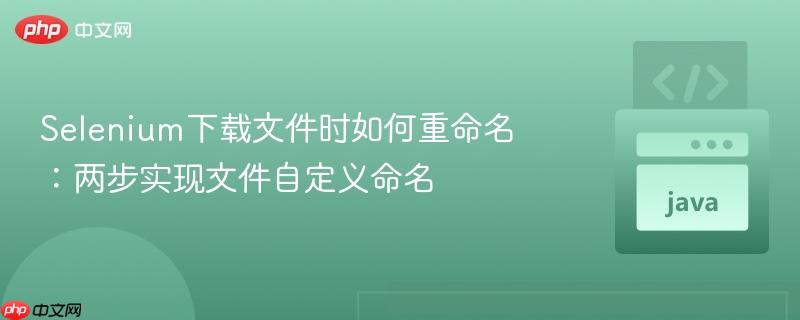
本教程将指导您如何在使用selenium进行文件下载时,克服系统默认随机命名的问题,实现文件的自定义命名。核心方法包括两步:首先通过chromeoptions配置下载目录,确保文件下载到指定位置;其次,利用java文件操作api,在文件下载完成后对其进行重命名,从而解决下载文件名称不可控的挑战。
在使用Selenium进行自动化测试或数据抓取时,经常会遇到需要下载文件的情况。然而,许多网站在文件下载时会生成随机或不规则的文件名,这给后续的文件处理和验证带来了不便。本教程将详细介绍如何通过配置Selenium WebDriver和利用Java文件操作,实现对下载文件的自定义命名。
为了能够对下载的文件进行重命名,首先需要确保文件下载到一个已知且可访问的目录。通过ChromeOptions可以设置Chrome浏览器的下载行为,包括禁用下载提示框和指定默认下载路径。
以下Java代码展示了如何初始化ChromeDriver并配置其下载目录:
import io.github.bonigarcia.wdm.WebDriverManager;
import org.openqa.selenium.WebDriver;
import org.openqa.selenium.chrome.ChromeDriver;
import org.openqa.selenium.chrome.ChromeOptions;
import java.io.File;
import java.util.HashMap;
import java.util.Map;
public class SeleniumDownloadConfig {
public static WebDriver setupDriverAndDownloadPath() {
// 自动管理 ChromeDriver 版本
WebDriverManager.chromedriver().setup();
ChromeOptions options = new ChromeOptions();
// 定义下载文件路径,这里设置为项目根目录下的 "downloads" 文件夹
String downloadFilepath = System.getProperty("user.dir") + File.separator + "downloads" + File.separator;
System.out.println("Chrome 下载路径设置为: " + downloadFilepath);
// 确保下载目录存在,如果不存在则创建
File downloadtoFolder = new File(downloadFilepath);
if (!downloadtoFolder.exists()) {
downloadtoFolder.mkdirs(); // 使用mkdirs确保创建所有必要的父目录
}
// 配置 Chrome 浏览器偏好设置
Map<String, Object> prefs = new HashMap<>();
prefs.put("credentials_enable_service", false); // 禁用凭据管理服务
prefs.put("profile.password_manager_enabled", false); // 禁用密码管理器
prefs.put("profile.default_content_settings.popups", 0); // 禁用弹出窗口
prefs.put("download.prompt_for_download", false); // 禁止弹出下载确认框
prefs.put("download.default_directory", downloadFilepath); // 设置默认下载目录
prefs.put("profile.default_content_setting_values.notifications", 1); // 允许通知 (可选)
prefs.put("profile.default_content_settings.cookies", 1); // 允许Cookies (可选)
options.setExperimentalOption("prefs", prefs);
// 初始化 ChromeDriver
WebDriver driver = new ChromeDriver(options);
return driver;
}
public static void main(String[] args) {
WebDriver driver = setupDriverAndDownloadPath();
// 示例:导航到需要下载文件的页面
// driver.get("http://example.com/download_page");
// 执行下载操作,例如点击下载按钮
// driver.findElement(By.id("downloadButton")).click();
// 实际应用中,您会在下载操作后调用文件重命名方法
// fileRename("my_receipt.pdf", System.getProperty("user.dir") + File.separator + "downloads" + File.separator);
// driver.quit(); // 完成操作后关闭浏览器
}
}文件下载到指定目录后,下一步就是通过编程方式找到该文件并将其重命名。这通常涉及遍历下载目录,识别目标文件,然后执行重命名操作。
以下Java方法演示了如何重命名下载目录中的文件。
import java.io.File;
import java.util.Arrays;
import java.util.List;
import java.util.concurrent.TimeUnit; // 用于等待文件下载完成
public class FileRenamer {
/**
* 重命名指定目录下的文件。
* 注意:此方法会遍历指定目录下所有文件,并尝试将它们重命名为 newFileName。
* 在实际应用中,您可能需要更精确的逻辑来识别要重命名的文件(例如,根据下载时间或原始文件名模式)。
*
* @param newFileName 新的文件名(包含扩展名)。
* @param folder 下载文件所在的目录路径。
*/
public static void fileRename(String newFileName, String folder) {
File directory = new File(folder);
System.out.println("正在读取目录: " + directory.toString());
// 确保目录存在且是目录
if (directory.isDirectory()) {
// 等待一段时间,确保文件下载完成并出现在目录中
try {
TimeUnit.SECONDS.sleep(5); // 可根据实际下载速度调整等待时间
} catch (InterruptedException e) {
Thread.currentThread().interrupt();
System.err.println("等待文件下载完成时被中断: " + e.getMessage());
return;
}
File[] files = directory.listFiles();
if (files == null || files.length == 0) {
System.out.println("目录中没有文件可供重命名。");
return;
}
List<File> fileList = Arrays.asList(files);
// 遍历目录中的所有文件
fileList.forEach(f -> {
System.out.println("发现文件: " + f.getAbsolutePath());
String newFullPath = folder + newFileName; // 新文件的完整路径
File newFile = new File(newFullPath);
// 避免将文件重命名为自身(如果新旧名称相同)
if (f.getAbsolutePath().equals(newFile.getAbsolutePath())) {
System.out.println(String.format("文件 %s 已是目标名称,无需重命名。", f.getName()));
return;
}
boolean isRenamed = f.renameTo(newFile);
if (isRenamed) {
System.out.println(String.format("已将文件 %s 重命名为 %s", f.getName(), newFileName));
} else {
System.err.println(String.format("文件 %s 未能重命名为 %s。可能原因:文件正在被使用,或权限不足,或目标文件已存在。", f.getName(), newFileName));
}
});
} else {
System.err.println("提供的路径不是一个有效的目录: " + folder);
}
}
public static void main(String[] args) {
// 示例用法:假设文件已下载到 "downloads" 目录
String downloadDir = System.getProperty("user.dir") + File.separator + "downloads" + File.separator;
// 模拟创建一些文件用于测试
try {
File dummyFile1 = new File(downloadDir + "random_12345.pdf");
dummyFile1.createNewFile();
File dummyFile2 = new File(downloadDir + "another_file.txt");
dummyFile2.createNewFile();
System.out.println("模拟文件已创建。");
} catch (Exception e) {
e.printStackTrace();
}
// 调用重命名方法
fileRename("my_custom_receipt.pdf", downloadDir);
// 清理模拟文件
new File(downloadDir + "my_custom_receipt.pdf").delete();
// 如果有其他文件,也需要清理
new File(downloadDir + "another_file.txt").delete();
System.out.println("模拟文件已清理。");
}
}通过以上两步,您可以在使用Selenium下载文件时实现对其文件名的自定义控制。首先,通过ChromeOptions配置下载目录,确保文件下载到已知位置;其次,在文件下载完成后,利用Java的文件操作API对其进行重命名。这种方法提供了一个灵活且强大的解决方案,有助于简化自动化测试和数据处理流程。请务必根据您的具体应用场景,对文件下载完成的判断逻辑和目标文件的识别策略进行细化,以确保解决方案的健壮性。
以上就是Selenium下载文件时如何重命名:两步实现文件自定义命名的详细内容,更多请关注php中文网其它相关文章!

每个人都需要一台速度更快、更稳定的 PC。随着时间的推移,垃圾文件、旧注册表数据和不必要的后台进程会占用资源并降低性能。幸运的是,许多工具可以让 Windows 保持平稳运行。

Copyright 2014-2025 https://www.php.cn/ All Rights Reserved | php.cn | 湘ICP备2023035733号